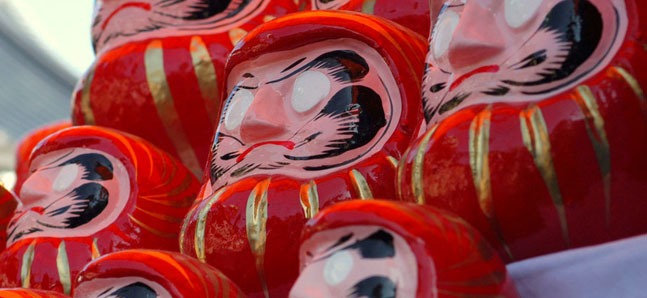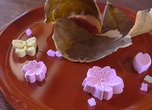Jindaiji’s Daruma-Ichi heralds spring
Special Gansan Daishi spirited, Brāhmī eyed daruma bring good fortune

Posted: Wed Mar 03 2010
Spring is almost upon us. To welcome its impending arrival, Chofu-shi’s Jindaiji temple is once again holding its annual ‘Daruma-ichi’ – one of Japan’s big three daruma doll fairs – on March 3 and 4.
Traditionally, daruma are modelled after the image of Bodhidharma, a monk who lived during the fifth century, and to whom the transmission of Zen Buddhism to China is accredited. This legendary monk wore red, a colour thought to guard against evil since long ago, and hence daruma are almost always painted red. The daruma’s thick eyebrows and beard are drawn to depict a face laden with courage; however, depending on where you buy your Jindaiji daruma, he may have a slightly different expression. Each stall arranges its daruma in a unique display, so comparing and choosing which one to buy can be good fun in itself.
Jindaiji’s ‘Daruma-ichi’ is also unique for partnering its daruma doll fair with a Yakuyoke-Gansan-Daishi festival. Here, pieces of scented wood are burnt inside a goma-dan (a special type of altar for burning holy objects) for spiritual purification and as a prayer to ward off evil.
The festival’s namesake, Gansan Daishi, was a legendary monk from Japan’s Heian period (794-1185) and said to have possessed powers to ward off evil. He was so renowned that, according to literature from the Edo period (1603-1868), his miraculous exploits drew pilgrims from all over Japan to pay homage and seek his blessing.
Back inside Jindaiji, in front of the Gansan-Daishi shrine, you’ll find a special area where, upon request, a monk will fill in the left eye of your newly purchased daruma with a letter from the Indian bonji (Brāhmī) script (equivalent to the Japanese character for ‘a’). This special character signifies that a wish has been made or ‘begun’. Its left eye painted, the daruma is then taken inside the Gansan-Daishi shrine, and momentarily placed next to the flame from the goma-dan, thereby receiving Gansan Daishi’s wisdom and spirit. When your wish is fulfilled, the right eye should be filled in with the second bonji character (equating to the Japanese character for ‘n’ and the last letter in the Japanese alphabet), to signify that the wish has been granted or ‘ended’.
Other festival highlights include the Oneri-Gyoretsu and the Gansan-Daishi-Mieku. In the Oneri-Gyoretsu, the high priest is draped in splendid clothing, notably a special gold-brocade kesa (an oblong piece of ornamental cloth worn over the robe by a Buddhist priest). He performs the Mieku, parading around the temple grounds together with gagaku musicians (ceremonial court music and dance), a group chanting kiyari (workmen’s chant) and fellow monks. The Gansan-Daishi-Mieku is a traditional Buddhist service where items such as incense, flowers and votive light are offered in thanks to an image of Gansan Daishi depicted in a hanging scroll.
To first herald the Tokyo spring and welcome some good fortune of your own, head over to Jindaiji, buy a daruma, make a wish and get involved!
Jindaiji Daruma-ichi
Date: Wed Mar 3-Thur Mar 4
Time: 9am–6pm
Address: 5-15-1 Jindaiji-Motomachi, Chofu, Tokyo
Telephone: (042)486 5511
Schedule: Hyakumi-Kuyo, Oneri-gyoretsu and Dai-Goma-hoshu both days from 2pm;
Daishidou-Goma-Kigan 10am, 11am, 12noon, 1pm, 2pm (Dai-Goma), 3.30pm and 4.30pm;
Daruma-Kaigan (daruma eye painting) at Daishido Nishimandokoro 9am–6pm
Website: www.jindaiji.or.jp/
Related articles:
・Tokyo’s charms
Cool charms with blessings and beauty
・Ladies’ love shrines
Ten shrines to help realise dreams of love & romance
・Auspicious running courses 2010
Detox and relax with an auspicious run to kickstart the year
Tags:
Tweets
- About Us |
- Work for Time Out |
- Send us info |
- Advertising |
- Mobile edition |
- Terms & Conditions |
- Privacy policy |
- Contact Us
Copyright © 2014 Time Out Tokyo











Add your comment